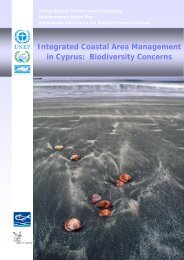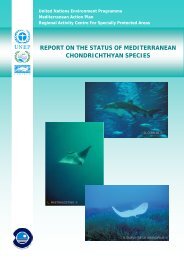Proceedings of the Second Mediterranean Symposium on Marine
Proceedings of the Second Mediterranean Symposium on Marine
Proceedings of the Second Mediterranean Symposium on Marine
Create successful ePaper yourself
Turn your PDF publications into a flip-book with our unique Google optimized e-Paper software.
PROCEEDINGS OF THE SECOND MEDITERRANEAN SYMPOSIUM ON MARINE VEGETATION (ATHENS, 12-13 DECEMBER 2003)<br />
48<br />
The recovery <str<strong>on</strong>g>of</str<strong>on</strong>g> Cystoseira forests, after <str<strong>on</strong>g>the</str<strong>on</strong>g> causes <str<strong>on</strong>g>of</str<strong>on</strong>g> <str<strong>on</strong>g>the</str<strong>on</strong>g>ir decline have ceased to<br />
operate, generally takes a very l<strong>on</strong>g time. Eight years after <str<strong>on</strong>g>the</str<strong>on</strong>g> setting up <str<strong>on</strong>g>of</str<strong>on</strong>g> <str<strong>on</strong>g>the</str<strong>on</strong>g> Marseilles<br />
(Provence, France) sewage treatment plant, <str<strong>on</strong>g>the</str<strong>on</strong>g> recovery <str<strong>on</strong>g>of</str<strong>on</strong>g> Cystoseira amentacea was<br />
hardly discernible (Soltan, 2001; Soltan et al., 2001). The reas<strong>on</strong> may be that Cystoseira<br />
eggs are ra<str<strong>on</strong>g>the</str<strong>on</strong>g>r large, sink rapidly and <str<strong>on</strong>g>the</str<strong>on</strong>g>refore are probably not disseminated bey<strong>on</strong>d a<br />
few meters from parent individuals (Guern, 1963, 1964; Lüning, 1990), as occurs in<br />
Sargassum species (Chapman, 1986). In additi<strong>on</strong>, <str<strong>on</strong>g>the</str<strong>on</strong>g> growth <str<strong>on</strong>g>of</str<strong>on</strong>g> most Cystoseira<br />
species is quite slow (Verlaque, 1987b). As a result, where C. amentacea has been<br />
extirpated from large areas, step-by-step recovery can take decades (Soltan et al., 2001).<br />
The absence <str<strong>on</strong>g>of</str<strong>on</strong>g> col<strong>on</strong>izati<strong>on</strong> by Cystoseira species <str<strong>on</strong>g>of</str<strong>on</strong>g> some breakwaters c<strong>on</strong>structed<br />
decades ago (and apparently suitable) highlights <str<strong>on</strong>g>the</str<strong>on</strong>g> difficulty <str<strong>on</strong>g>of</str<strong>on</strong>g> <str<strong>on</strong>g>the</str<strong>on</strong>g>se species in<br />
col<strong>on</strong>izing new or lost habitats.<br />
A CASE STUDY: THE FATE OF LITHOPHYLLUM BYSSOIDES TROTTOIRS<br />
The incrusting coralline Lithophyllum byssoides (Rhodobi<strong>on</strong>ta, Plantae), previously<br />
known as L. lichenoides or L. tortuosum, lives in <str<strong>on</strong>g>the</str<strong>on</strong>g> lower midlittoral z<strong>on</strong>e, i.e. slightly<br />
above mean sea level. Under c<strong>on</strong>diti<strong>on</strong>s <str<strong>on</strong>g>of</str<strong>on</strong>g> dim light and str<strong>on</strong>g surf exposure, e.g. in<br />
small coves, corridors, fends, crannies and al<strong>on</strong>g cliffs, it builds up rims; wide rims are<br />
usually named "trottoirs". They c<strong>on</strong>sist <str<strong>on</strong>g>of</str<strong>on</strong>g> a wide overhanging cornice with a flat or slightly<br />
depressed upper surface, ending in a salient rim with a vertical face (Delamare-<br />
Debouteville and Bougis, 1951; Blanc and Molinier, 1955; Pérès and Picard, 1964;<br />
Laborel, 1987; Laborel et al., 1994a).<br />
The Lithophyllum byssoides rim is a comm<strong>on</strong> feature in <str<strong>on</strong>g>the</str<strong>on</strong>g> nor<str<strong>on</strong>g>the</str<strong>on</strong>g>rn and central parts<br />
<str<strong>on</strong>g>of</str<strong>on</strong>g> <str<strong>on</strong>g>the</str<strong>on</strong>g> western <str<strong>on</strong>g>Mediterranean</str<strong>on</strong>g> basin and <str<strong>on</strong>g>the</str<strong>on</strong>g> Adriatic Sea. The most spectacular trottoirs<br />
are those <str<strong>on</strong>g>of</str<strong>on</strong>g> Grand Langoustier <strong>on</strong> Porquerolles Island (Provence, France), Cala Litizia<br />
(Punta Palazzu, Scandola nature Reserve, Corsica) and Kvarner Gulf (Croatia). They are<br />
2 m wide in places. Lithophyllum byssoides rims are less comm<strong>on</strong> in <str<strong>on</strong>g>the</str<strong>on</strong>g> south <str<strong>on</strong>g>of</str<strong>on</strong>g> <str<strong>on</strong>g>the</str<strong>on</strong>g><br />
western basin and very rare in <str<strong>on</strong>g>the</str<strong>on</strong>g> eastern basin (Huvé, 1963; Lovric, 1971; Zimmermann,<br />
1982; Bianc<strong>on</strong>i et al., 1987; Harmelin et al., 1987; Laborel, 1987; Laborel et al.,<br />
1994a).<br />
Datings by 14 C have shown that <str<strong>on</strong>g>the</str<strong>on</strong>g> building up <str<strong>on</strong>g>of</str<strong>on</strong>g> large Lithophyllum byssoides trottoirs<br />
takes several centuries, even more than a thousand years, and a relatively stable (or just<br />
very slowly rising) sea level, which has rarely been <str<strong>on</strong>g>the</str<strong>on</strong>g> case over <str<strong>on</strong>g>the</str<strong>on</strong>g> last 30 000 years<br />
(Laborel et al., 1983, 1994b).<br />
The Lithophyllum byssoides trottoir is sensitive to polluti<strong>on</strong> (especially hydrocarb<strong>on</strong>s).<br />
The trottoirs have died in French Catal<strong>on</strong>ia, in <str<strong>on</strong>g>the</str<strong>on</strong>g> Marseilles area (France) and in <str<strong>on</strong>g>the</str<strong>on</strong>g> Gulf<br />
<str<strong>on</strong>g>of</str<strong>on</strong>g> Palermo (Sicily): bio-erosi<strong>on</strong> (perforating organisms) no l<strong>on</strong>ger being compensated for<br />
by bio-c<strong>on</strong>structi<strong>on</strong>, <str<strong>on</strong>g>the</str<strong>on</strong>g>y are progressively eroded and end up disappearing (Laborel<br />
et al., 1994a; Riggio et al., 1994). Bearing in mind <str<strong>on</strong>g>the</str<strong>on</strong>g> length <str<strong>on</strong>g>of</str<strong>on</strong>g> time it takes for <str<strong>on</strong>g>the</str<strong>on</strong>g>m














